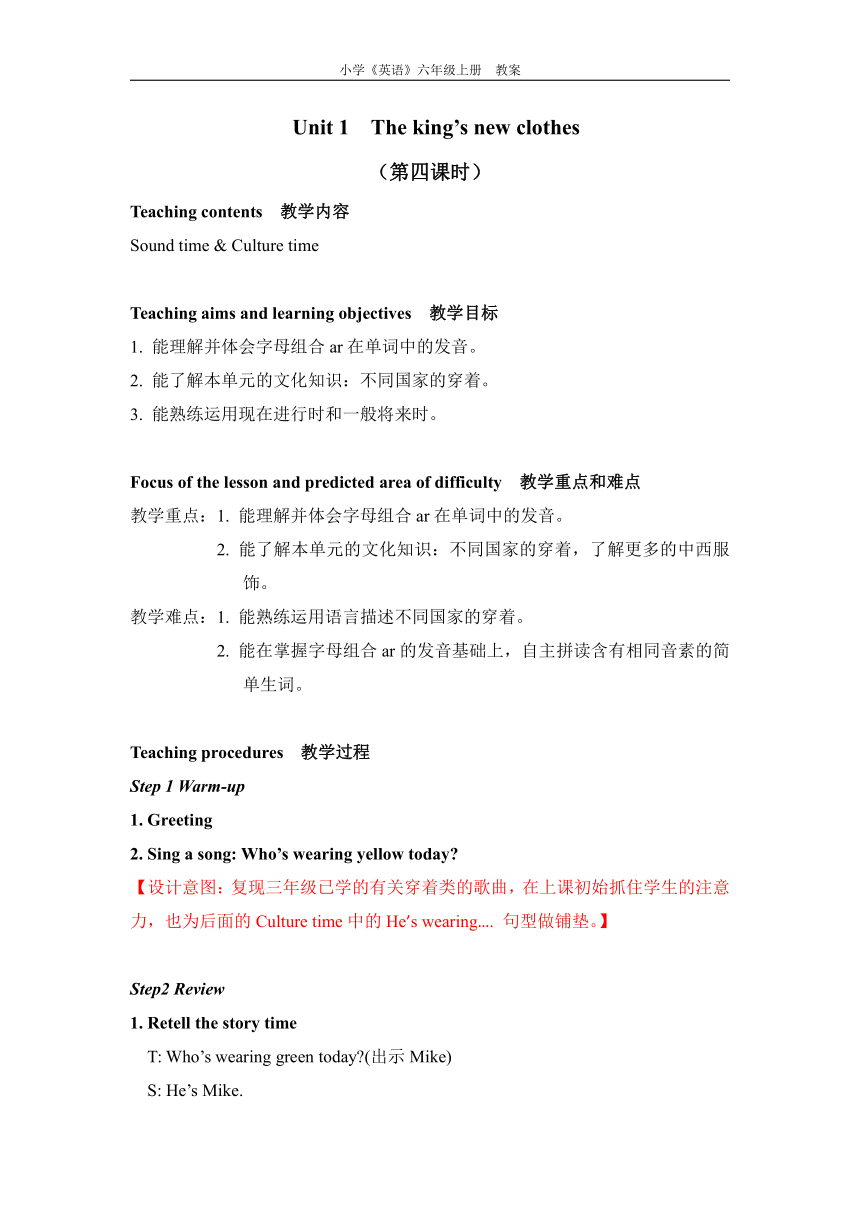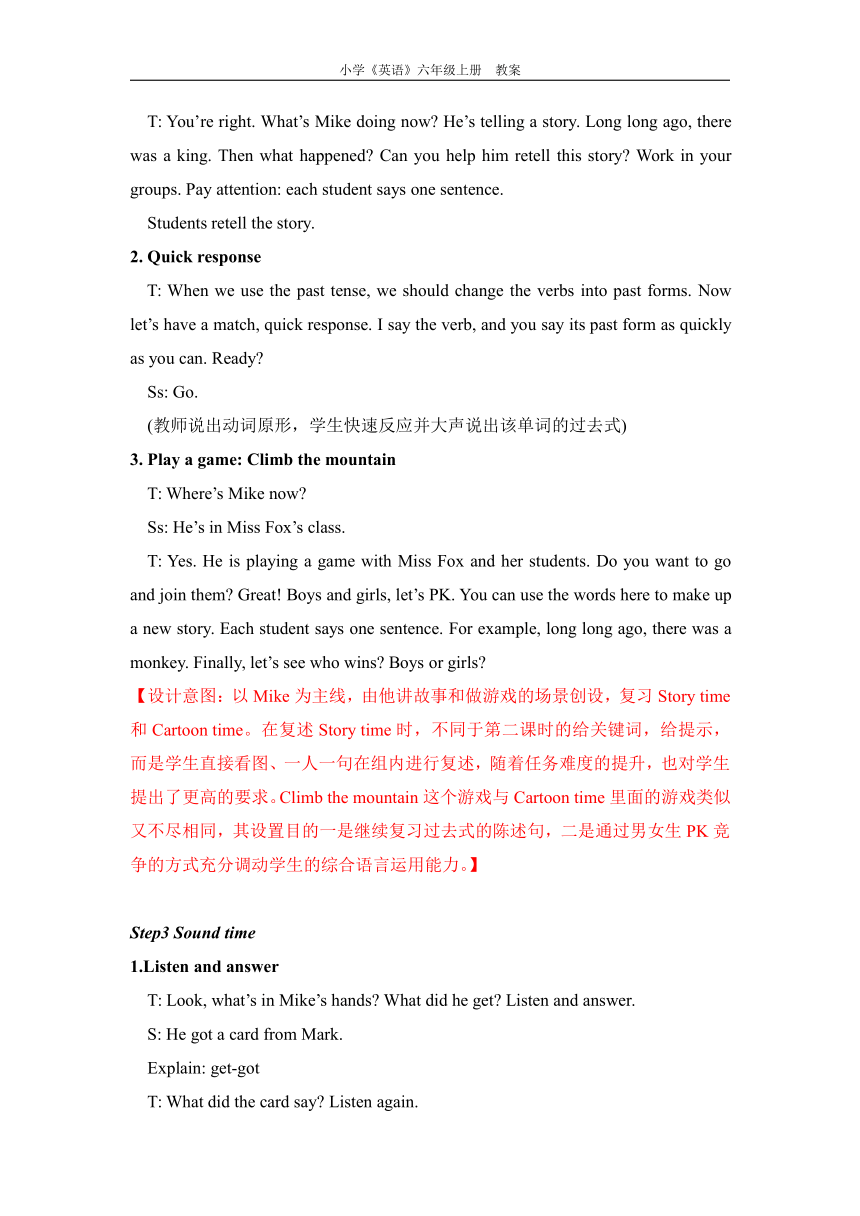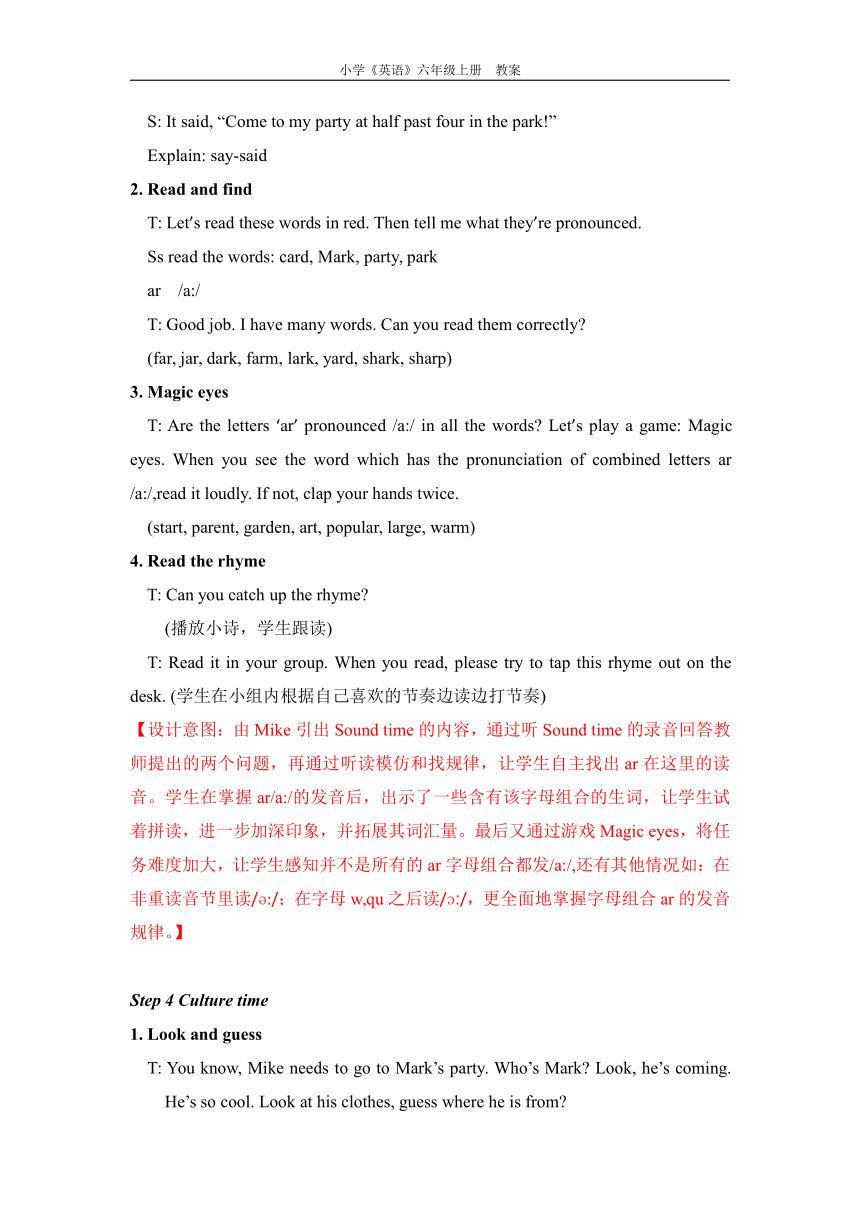Unit1 The king’s new clothes Sound time 教案
文档属性
| 名称 | Unit1 The king’s new clothes Sound time 教案 |  | |
| 格式 | zip | ||
| 文件大小 | 11.8KB | ||
| 资源类型 | 教案 | ||
| 版本资源 | 牛津译林版 | ||
| 科目 | 英语 | ||
| 更新时间 | 2019-12-21 17:07:10 | ||
图片预览



文档简介
Unit 1 The king’s new clothes
(第四课时)
Teaching contents 教学内容
Sound time & Culture time
Teaching aims and learning objectives 教学目标
1. 能理解并体会字母组合ar在单词中的发音。
2. 能了解本单元的文化知识:不同国家的穿着。
3. 能熟练运用现在进行时和一般将来时。
Focus of the lesson and predicted area of difficulty 教学重点和难点
教学重点:1. 能理解并体会字母组合ar在单词中的发音。
2. 能了解本单元的文化知识:不同国家的穿着,了解更多的中西服饰。
教学难点:1. 能熟练运用语言描述不同国家的穿着。
2. 能在掌握字母组合ar的发音基础上,自主拼读含有相同音素的简单生词。
Teaching procedures 教学过程
Step 1 Warm-up
1. Greeting
2. Sing a song: Who’s wearing yellow today?
【设计意图:复现三年级已学的有关穿着类的歌曲,在上课初始抓住学生的注意力,也为后面的Culture time中的He’s wearing…. 句型做铺垫。】
Step2 Review
1. Retell the story time
T: Who’s wearing green today?(出示Mike)
S: He’s Mike.
T: You’re right. What’s Mike doing now? He’s telling a story. Long long ago, there was a king. Then what happened? Can you help him retell this story? Work in your groups. Pay attention: each student says one sentence.
Students retell the story.
2. Quick response
T: When we use the past tense, we should change the verbs into past forms. Now let’s have a match, quick response. I say the verb, and you say its past form as quickly as you can. Ready?
Ss: Go.
(教师说出动词原形,学生快速反应并大声说出该单词的过去式)
3. Play a game: Climb the mountain
T: Where’s Mike now?
Ss: He’s in Miss Fox’s class.
T: Yes. He is playing a game with Miss Fox and her students. Do you want to go and join them? Great! Boys and girls, let’s PK. You can use the words here to make up a new story. Each student says one sentence. For example, long long ago, there was a monkey. Finally, let’s see who wins? Boys or girls?
【设计意图:以Mike为主线,由他讲故事和做游戏的场景创设,复习Story time和Cartoon time。在复述Story time时,不同于第二课时的给关键词,给提示,而是学生直接看图、一人一句在组内进行复述,随着任务难度的提升,也对学生提出了更高的要求。Climb the mountain这个游戏与Cartoon time里面的游戏类似又不尽相同,其设置目的一是继续复习过去式的陈述句,二是通过男女生PK竞争的方式充分调动学生的综合语言运用能力。】
Step3 Sound time
1.Listen and answer
T: Look, what’s in Mike’s hands? What did he get? Listen and answer.
S: He got a card from Mark.
Explain: get-got
T: What did the card say? Listen again.
S: It said, “Come to my party at half past four in the park!”
Explain: say-said
2. Read and find
T: Let’s read these words in red. Then tell me what they’re pronounced.
Ss read the words: card, Mark, party, park
ar /a:/
T: Good job. I have many words. Can you read them correctly?
(far, jar, dark, farm, lark, yard, shark, sharp)
3. Magic eyes
T: Are the letters ‘ar’ pronounced /a:/ in all the words? Let’s play a game: Magic eyes. When you see the word which has the pronunciation of combined letters ar /a:/,read it loudly. If not, clap your hands twice.
(start, parent, garden, art, popular, large, warm)
4. Read the rhyme
T: Can you catch up the rhyme?
(播放小诗,学生跟读)
T: Read it in your group. When you read, please try to tap this rhyme out on the desk. (学生在小组内根据自己喜欢的节奏边读边打节奏)
【设计意图:由Mike引出Sound time的内容,通过听Sound time的录音回答教师提出的两个问题,再通过听读模仿和找规律,让学生自主找出ar在这里的读音。学生在掌握ar/a:/的发音后,出示了一些含有该字母组合的生词,让学生试着拼读,进一步加深印象,并拓展其词汇量。最后又通过游戏Magic eyes,将任务难度加大,让学生感知并不是所有的ar字母组合都发/a:/,还有其他情况如:在非重读音节里读/?:/;在字母w,qu之后读/??/,更全面地掌握字母组合ar的发音规律。】
Step 4 Culture time
1. Look and guess
T: You know, Mike needs to go to Mark’s party. Who’s Mark? Look, he’s coming. He’s so cool. Look at his clothes, guess where he is from?
S: He’s from America.
T: Bill is at the party too. Look him, where is he from?
S: He’s from Scotland.
2. Let’s learn
T: But how do you know where they are from?
S: Because Mark is wearing jeans.
T: Very good. He’s a cowboy.
Listen to the introduction of American cowboy.
T: How do you know Bill’s from Scotland?
S: Because he’s wearing a kilt.
T: Well done. He’s a Scottish man.
Listen to the introduction of Scottish kilt.
3. Let’s read
4. Try to know
T: What clothing are they?
Picture 1: This is a Chinese woman. She’s wearing a cheongsam.
Picture 2: They are Koreans. They’re wearing hanbok.
Picture 3: This is a Japanese woman. She’s wearing kimono.
5. Think and talk
T: Boys and girls, it’s your turn. What else do you know about the clothing in China and the other countries? Now, discuss in your group. Use these sentences to talk. Ready?
This is a … She’s/He’s wearing …
6. Summary
(1) 介绍中国传统服饰:Hanfu, Cheongsam, Tang suit, Zhongshan suit, Chinese minority costumes
(2) 欣赏世界各地的服饰。Each country has their special national costume. Different countries, different clothing. Different clothing, different culture.
【设计意图:依旧抓住Mike这一主线,在Sound time中Mike要去参加Mark的派对,故把Culture time中出现的人物命名为Mark,通过观察图片猜一猜两个人物来自哪个国家,并让学生说出理由,自然引出Culture time的生词和句型。再继续通过聆听纯英文的介绍,加深学生对美国牛仔和苏格兰短裙的认识与了解。接下来,教师运用直观的图片向学生介绍中国的旗袍,韩国的汉服以及日本的和服,这既拓展了学生的知识面,也是在为学生后续的Think and talk环节做示范。然后将语言的主动权交给学生,教师课前让学生先通过网络等资源查找了中国以及世界各地的有代表性的服饰,做好知识储备;在课堂中学生通过讨论交流获取更多的信息源,最后运用本节课所学的句型This is a… She’s/He’s wearing …来进行操练,最大化地调动学生的主观能动性,教师只需在最后环节中通过总结将能代表中国的特色服饰和世界各地不同特色的服饰一一展示,学生自然能感受到不同的文化造就不同的服饰,不同的国家有着各自特色,开拓了学生的国际视野。】
Step 5 Consolidation
T: Look at this man. Where is he from? And what is he wearing?
S: He’s from Korea. He’s wearing hanbok.
T: What’s on his head?
S: There is a hat.
T: Great. But the hat is called gaht. It’s a very special hat. Let’s listen to the story of a hat called “Gaht”. Then answer my questions:
Q1: Who had to wear a hat named a “gaht”?
Q2: Who bought a new gaht for the yangban at last?
Listen and answer.
【设计意图:通过一则有趣的有关服饰的英文绘本故事,让学生更深层次的了解到在古代的韩国帽子也是身份的一种象征。在这一环节中,对于服饰的表述不在只是停留在Culture time里的句型,难度进一步加大并且与本单元的重点时态一般过去时相结合,提高学生的阅读理解水平。】
Homework 家庭作业
1. 抄写Culture time和Sound time各一遍。
2. 搜索各国民族服装,了解各国服装文化。
3. 诵读Sound time,进一步了解 ar 字母组合在单词中的发音。
Teaching aids 教学准备(含板书设计)
教学准备:PPT课件。
板书设计:
Unit 1 The king’s new clothes
(第四课时)
Teaching contents 教学内容
Sound time & Culture time
Teaching aims and learning objectives 教学目标
1. 能理解并体会字母组合ar在单词中的发音。
2. 能了解本单元的文化知识:不同国家的穿着。
3. 能熟练运用现在进行时和一般将来时。
Focus of the lesson and predicted area of difficulty 教学重点和难点
教学重点:1. 能理解并体会字母组合ar在单词中的发音。
2. 能了解本单元的文化知识:不同国家的穿着,了解更多的中西服饰。
教学难点:1. 能熟练运用语言描述不同国家的穿着。
2. 能在掌握字母组合ar的发音基础上,自主拼读含有相同音素的简单生词。
Teaching procedures 教学过程
Step 1 Warm-up
1. Greeting
2. Sing a song: Who’s wearing yellow today?
【设计意图:复现三年级已学的有关穿着类的歌曲,在上课初始抓住学生的注意力,也为后面的Culture time中的He’s wearing…. 句型做铺垫。】
Step2 Review
1. Retell the story time
T: Who’s wearing green today?(出示Mike)
S: He’s Mike.
T: You’re right. What’s Mike doing now? He’s telling a story. Long long ago, there was a king. Then what happened? Can you help him retell this story? Work in your groups. Pay attention: each student says one sentence.
Students retell the story.
2. Quick response
T: When we use the past tense, we should change the verbs into past forms. Now let’s have a match, quick response. I say the verb, and you say its past form as quickly as you can. Ready?
Ss: Go.
(教师说出动词原形,学生快速反应并大声说出该单词的过去式)
3. Play a game: Climb the mountain
T: Where’s Mike now?
Ss: He’s in Miss Fox’s class.
T: Yes. He is playing a game with Miss Fox and her students. Do you want to go and join them? Great! Boys and girls, let’s PK. You can use the words here to make up a new story. Each student says one sentence. For example, long long ago, there was a monkey. Finally, let’s see who wins? Boys or girls?
【设计意图:以Mike为主线,由他讲故事和做游戏的场景创设,复习Story time和Cartoon time。在复述Story time时,不同于第二课时的给关键词,给提示,而是学生直接看图、一人一句在组内进行复述,随着任务难度的提升,也对学生提出了更高的要求。Climb the mountain这个游戏与Cartoon time里面的游戏类似又不尽相同,其设置目的一是继续复习过去式的陈述句,二是通过男女生PK竞争的方式充分调动学生的综合语言运用能力。】
Step3 Sound time
1.Listen and answer
T: Look, what’s in Mike’s hands? What did he get? Listen and answer.
S: He got a card from Mark.
Explain: get-got
T: What did the card say? Listen again.
S: It said, “Come to my party at half past four in the park!”
Explain: say-said
2. Read and find
T: Let’s read these words in red. Then tell me what they’re pronounced.
Ss read the words: card, Mark, party, park
ar /a:/
T: Good job. I have many words. Can you read them correctly?
(far, jar, dark, farm, lark, yard, shark, sharp)
3. Magic eyes
T: Are the letters ‘ar’ pronounced /a:/ in all the words? Let’s play a game: Magic eyes. When you see the word which has the pronunciation of combined letters ar /a:/,read it loudly. If not, clap your hands twice.
(start, parent, garden, art, popular, large, warm)
4. Read the rhyme
T: Can you catch up the rhyme?
(播放小诗,学生跟读)
T: Read it in your group. When you read, please try to tap this rhyme out on the desk. (学生在小组内根据自己喜欢的节奏边读边打节奏)
【设计意图:由Mike引出Sound time的内容,通过听Sound time的录音回答教师提出的两个问题,再通过听读模仿和找规律,让学生自主找出ar在这里的读音。学生在掌握ar/a:/的发音后,出示了一些含有该字母组合的生词,让学生试着拼读,进一步加深印象,并拓展其词汇量。最后又通过游戏Magic eyes,将任务难度加大,让学生感知并不是所有的ar字母组合都发/a:/,还有其他情况如:在非重读音节里读/?:/;在字母w,qu之后读/??/,更全面地掌握字母组合ar的发音规律。】
Step 4 Culture time
1. Look and guess
T: You know, Mike needs to go to Mark’s party. Who’s Mark? Look, he’s coming. He’s so cool. Look at his clothes, guess where he is from?
S: He’s from America.
T: Bill is at the party too. Look him, where is he from?
S: He’s from Scotland.
2. Let’s learn
T: But how do you know where they are from?
S: Because Mark is wearing jeans.
T: Very good. He’s a cowboy.
Listen to the introduction of American cowboy.
T: How do you know Bill’s from Scotland?
S: Because he’s wearing a kilt.
T: Well done. He’s a Scottish man.
Listen to the introduction of Scottish kilt.
3. Let’s read
4. Try to know
T: What clothing are they?
Picture 1: This is a Chinese woman. She’s wearing a cheongsam.
Picture 2: They are Koreans. They’re wearing hanbok.
Picture 3: This is a Japanese woman. She’s wearing kimono.
5. Think and talk
T: Boys and girls, it’s your turn. What else do you know about the clothing in China and the other countries? Now, discuss in your group. Use these sentences to talk. Ready?
This is a … She’s/He’s wearing …
6. Summary
(1) 介绍中国传统服饰:Hanfu, Cheongsam, Tang suit, Zhongshan suit, Chinese minority costumes
(2) 欣赏世界各地的服饰。Each country has their special national costume. Different countries, different clothing. Different clothing, different culture.
【设计意图:依旧抓住Mike这一主线,在Sound time中Mike要去参加Mark的派对,故把Culture time中出现的人物命名为Mark,通过观察图片猜一猜两个人物来自哪个国家,并让学生说出理由,自然引出Culture time的生词和句型。再继续通过聆听纯英文的介绍,加深学生对美国牛仔和苏格兰短裙的认识与了解。接下来,教师运用直观的图片向学生介绍中国的旗袍,韩国的汉服以及日本的和服,这既拓展了学生的知识面,也是在为学生后续的Think and talk环节做示范。然后将语言的主动权交给学生,教师课前让学生先通过网络等资源查找了中国以及世界各地的有代表性的服饰,做好知识储备;在课堂中学生通过讨论交流获取更多的信息源,最后运用本节课所学的句型This is a… She’s/He’s wearing …来进行操练,最大化地调动学生的主观能动性,教师只需在最后环节中通过总结将能代表中国的特色服饰和世界各地不同特色的服饰一一展示,学生自然能感受到不同的文化造就不同的服饰,不同的国家有着各自特色,开拓了学生的国际视野。】
Step 5 Consolidation
T: Look at this man. Where is he from? And what is he wearing?
S: He’s from Korea. He’s wearing hanbok.
T: What’s on his head?
S: There is a hat.
T: Great. But the hat is called gaht. It’s a very special hat. Let’s listen to the story of a hat called “Gaht”. Then answer my questions:
Q1: Who had to wear a hat named a “gaht”?
Q2: Who bought a new gaht for the yangban at last?
Listen and answer.
【设计意图:通过一则有趣的有关服饰的英文绘本故事,让学生更深层次的了解到在古代的韩国帽子也是身份的一种象征。在这一环节中,对于服饰的表述不在只是停留在Culture time里的句型,难度进一步加大并且与本单元的重点时态一般过去时相结合,提高学生的阅读理解水平。】
Homework 家庭作业
1. 抄写Culture time和Sound time各一遍。
2. 搜索各国民族服装,了解各国服装文化。
3. 诵读Sound time,进一步了解 ar 字母组合在单词中的发音。
Teaching aids 教学准备(含板书设计)
教学准备:PPT课件。
板书设计:
Unit 1 The king’s new clothes
